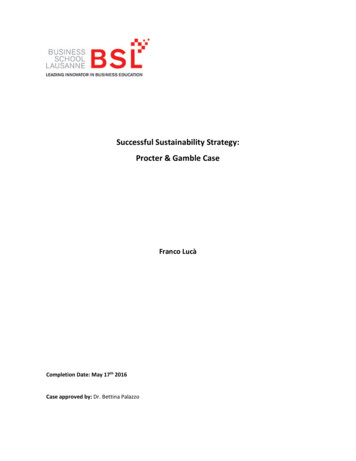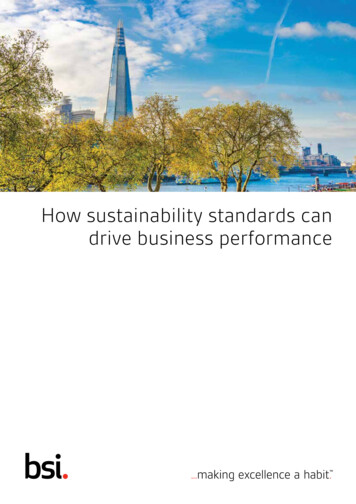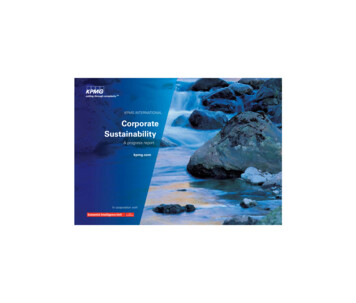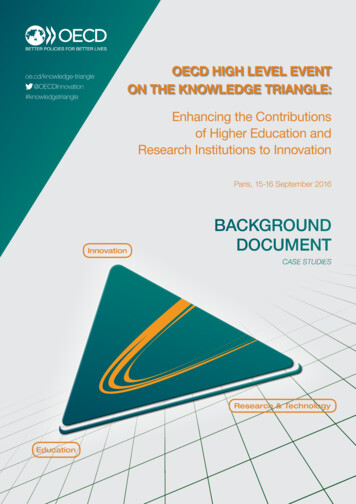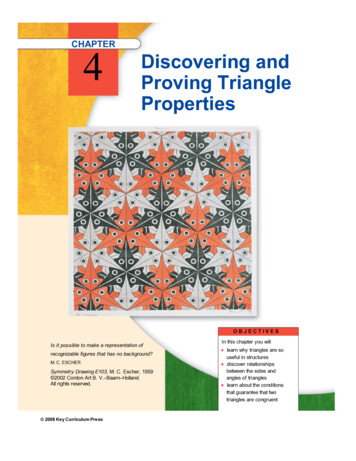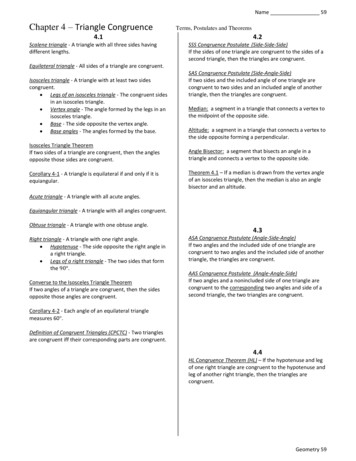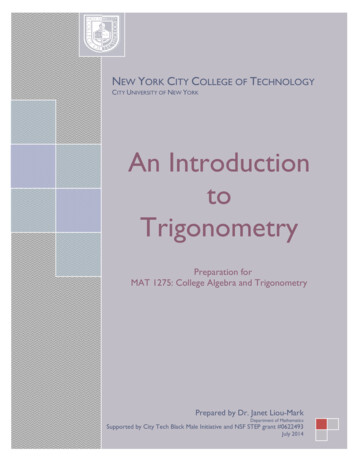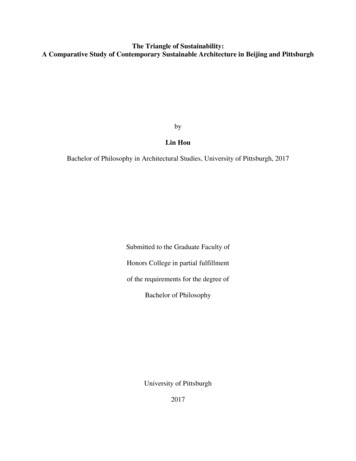
Transcription
The Triangle of Sustainability:A Comparative Study of Contemporary Sustainable Architecture in Beijing and PittsburghbyLin HouBachelor of Philosophy in Architectural Studies, University of Pittsburgh, 2017Submitted to the Graduate Faculty ofHonors College in partial fulfillmentof the requirements for the degree ofBachelor of PhilosophyUniversity of Pittsburgh2017
UNIVERSITY OF PITTSBURGHHonors CollegeThis thesis was presentedbyLin HouIt was defended onApril 4th, 2017and approved byMrinalini Rajagopalan, PhD, Assistant ProfessorStefan Al, PhD, Assistant ProfessorMelissa Bilec, PhD, Assistant ProfessorDrew Armstrong, PhD, Associate ProfessorThesis Director: Mrinalini Rajagopalan, PhD, Assistant Professorii
Copyright by Lin Hou2017iii
The Triangle of Sustainability:A Comparative Study of Contemporary Sustainable Architecture in Beijing andPittsburghLin Hou, B.PhilSustainable architecture is increasingly becoming not only iconic of higher life quality,but also a great tool to reduce energy usage in response to global climate change concerns. Moreand more, sustainable architecture has diverse foci based on what standards (such as LEED)architects choose. Looking at those standards, and how different architects approach them, itbecomes essential to look for similarities and differences.In 2015 at the United Nations Climate Change Conference, the two largest polluters—America and China—committed themselves to cut CO2 emissions. In this study I am performinga comparative analysis of two recently designed major buildings in Pittsburgh and Beijing, twotop cities in America and China which are developing sustainable architecture in response tosimilar climate issues: the New Tower in PNC Plaza and the Parkview Green Mall in Beijing.There are two core questions that I intend to answer by the end of this research project:(1) Why does each building go beyond minimum sustainability standards required in itsrespective country? (2) What are each project’s respective foci in designing their ownsustainability solutions? I will first analyze two different standards applied in two case studies—the U.S. LEED (Leadership in Energy and Environmental Design) and China’s GB (EvaluationStandard for Green Building). How does each standard address different climate issues and howapplicable are they in their respective countries?In order to make the comparison between these two buildings easier to understand, I willfocus on their similarities and differences in five major categories: standards, human use, multiiv
functionality, focus of sustainability, and central ventilation. However, the comparison is notlimited to these categories. For example, communication and raising public awareness aboutsustainability is another aspect that I explore. My honors thesis includes a website whichcontains a short movie and animations (click here to watch the full version of the movie) to helpexplain my research project in greater detail.v
TABLE OF CONTENTSACKNOWLEDGEMENTS: . X1.0UNDERSTANDING THE ROLES OF SUSTAINABLE ARCHITECTURE . 12.0LITERATURE REVIEW. 82.1HISTORICAL DEVELOPMENT OF GREEN ARCHITECTURE . 82.2REGIONAL PERSPECTIVES: SUSTAINABLE PRACTICES IN THE U.S.AND CHINA . 112.33.0PROPOSAL OF FUTURE SUSTAINABLE ARCHITECTURE. 12SUSTAINABILITY STANDARDS: ENCOURAGING OR RESTRICTING? . 153.1LEED . 153.2GB. 173.3COMPARISON BETWEEN LEED AND GB . 194.0SUSTAINABLE ARCHITECTURE IN PITTSBURGH AND BEIJING . 235.0NEW TOWER AT PNC PLAZA VS PARKVIEW GREEN MALL . 255.1PNC TOWER . 255.1.1PNC Tower: The Company’s Philosophy . 255.1.2PNC Tower: Community Design . 275.1.3PNC Tower: Ventilation Technology . 295.1.4PNC Tower: Other Sustainable Strategies . 32vi
5.1.55.2PNC Tower: Social and Cultural Factors . 33PARKVIEW GREEN MALL . 345.2.1Parkview Green Mall: Introduction on Parkview Family . 345.2.2Parkview Green Mall: Design of “Complexity” . 365.2.3Parkview Green Mall: Design Philosophy of a Bridge for theCommunity . 405.2.4Parkview Green Mall: A Different Design of Innovative NaturalVentilation. 416.05.2.5Parkview Green Mall: Other Sustainable Strategies . 425.2.6Parkview Green Mall: Social and Cultural Factors . 43COMPARISON OF PNC TOWER AND PARKVIEW GREEN MALL . 456.1ALTERNATIVE DESIGN THINKING . 456.2SUSTAINABILITY FOCI . 466.3CENTRAL VENTILATION SYSTEM . 486.4MULTI-FUNCTIONAL SPACES . 507.0PNC TOWER AND PARKVIEW GREEN MALL: A CRITIQUE . 538.0WHAT IS THE FUTURE OF SUSTAINABLE ARCHITECTURE . 55BIBLIOGRAPHY . 60vii
LIST OF TABLESTable 1: GB Weighted System . 18viii
LIST OF FIGURESFigure 1: Triangle of Sustainability . 6Figure 2: New Tower at PNC Plaza. 26Figure 3: PNC Tower: Lobby View. 28Figure 4: Double Skin Facade. 30Figure 5: PNC Tower Color Coded Floor Plan . 33Figure 6: Parkview Green Mall. 35Figure 7: Semi-Public Space of Parkview Green Mall . 37Figure 8: Parkview Green Mall: Atrium . 38Figure 9: Parkview Green Mall: Bridge. 40Figure 10: Installation on the Bridge . 41Figure 11: PNC Tower: Street View . 46Figure 12: Parkview Green Mall: Indoor Garden . 49Figure 13: Parkview Green Mall: Multi-functional Spaces . 51ix
ACKNOWLEDGEMENTS:I obtained a lot support and assistance from many people in many different fields, whichled to the success and final outcome of this thesis. Even though one page of acknowledgmentscannot express how much I have appreciated the help that I have received from so many people,what I have accomplished is only due to their guidance, and I would like to use this opportunityto express my gratitude to them.I owe my sincere and profound gratitude to my committee chair, Professor MrinaliniRajagopalan, whose selfless devotion to the field has continually inspired me to be a criticalthinker and always encouraged me to push this research to a higher understanding for the pastthree years. Without her guidance and consistent help, this thesis would not have achieved aB.Phil thesis level.I would like to thank my supportive committee members, Professor Stefan Al, ProfessorMelissa Bilec, and Professor Drew Armstrong, who have given me extra assistance anddemonstrated to me how to connect my thesis to more related professional fields in city planning,engineering technology, management, and history.I would like to acknowledge Dr. Peter Koehler, the director of the Brackenridge SummerResearch Fellowship program, for freely offering encouragement and timely support for thesuccessful completion of my thesis.x
1.0UNDERSTANDING THE ROLES OF SUSTAINABLE ARCHITECTURESustainability has been defined by the United Nations as “development that meets the needs ofthe present without compromising the ability of future generations to meet their own needs.” 1Over the last half century, the understanding of sustainability by citizens, architectural andengineering firms, and local governments has increasingly grown from the limited view of purelycutting industrial pollution and reducing CO2 emissions to more ambitious programs ofreversing or neutralizing climate change. One example of this increasing attention tosustainability is the U.S. non-profit organization called Architecture 2030, which is comprised ofarchitectural firms, suppliers, community organizations, and local/state governments who haveproposed the 2030 Challenge, in which all new buildings, developments, and major renovationsin the U.S. shall be carbon-neutral by 2030. 2 The organization has received support from the U.S.Department of Energy. Such bold moves by governments, non-profit organizations, anddesigners have spurred my curiosity about how climate change problems can be addressedthrough responsible design of the built environment. 3Finding solutions to climate change is becoming an unavoidable responsibility for majorcountries, such as the U.S. and China, which are also currently the world’s two greatest polluters.Architects around the globe are paying close attention to how these countries solve climate /sustdev.shtml, accessed February 12th, 2017.http://architecture2030.org/2030 challenges/2030-challenge/, accessed March 18th, 20173http://architecture2030.org, accessed March 18th, 2017.21
in order to emulate their approaches. Therefore, it is important to study how the two countriesapproach and develop their own standards for sustainability. By comparing their approachestowards sustainable architecture, this analysis can be used as a toolkit for other countries that arelooking for guidelines of sustainability.However, because the challenge of climate change is so great, cutting emissions andachieving sustainability will require an all-out effort by all stake-holders. The field ofarchitectural design is contributing to this effort in the area of sustainable architecture. In theUnited States, architecture consumes 48% of total energy resources, as opposed to thetransportation sector, which only accounts for 27% of energy consumption. 4 Therefore,technological innovation and widespread adoption of sustainable architecture can make asignificant impact on the future of sustainability. In this thesis, I compare two recent sustainablebuildings in the U.S. and China and investigate the different approaches employed by bothdevelopers and architects with regard to sustainable solutions. By doing the comparisons, I aimto highlight three different aspects of sustainable architecture. Perhaps most importantly, Iemphasize that sustainable architecture should go beyond simple energy savings and resourcemanagement to ultimately inspiring other developers to pursue sustainability and fosteringsustainable lifestyles within the community.In the U.S., there are many sustainable standards such as LEED, the Living BuildingChallenge, and Life Cycle Assessment (LCA). The most widely used set of sustainabilityguidelines, LEED (Leadership in Energy and Environmental Design), is more directly related todesign strategy towards energy saving and resource conservation in architecture. LEED has fourlevels—Certified, Silver, Gold, and Platinum. Although it is not a requirement that buildings4Susan S. Szenasy, “ Reflections On Sustainable Design,” Volume 37, Number 1, ix.2
have to receive LEED certification, most architectural design firms in the U.S. voluntarily aspireto LEED certification in their projects. 5 In this thesis, LEED will be the primary U.S. standardused to examine how two recent buildings in Pittsburgh and Beijing have been designed toachieve LEED’s sustainable accreditation. In China, some Chinese design firms also followLEED. More importantly, all Chinese design firms must adhere to minimum governmentsustainability regulations, which are called GB (Evaluation Standard for Green Building). GB isdifferent from LEED in that it is a governmentally mandated green architectural law.Government plays an essential role here to make sure all new construction in China reaches aminimum sustainable standard. As large developers in China look towards international clientele,LEED has become a more attractive certification than GB.My methodology for research has been interdisciplinary and multi-sited. In order togather evidence for this project, I visited both PNC Tower and Parkview Green Mall multipletimes, where I was able to observe user behavior and also experience the environment of bothbuildings in an intimate way. In order to better understand PNC’s design and sustainabilitysolutions, I interviewed Angelica Ciranni, the former sustainability analyst at PNC, as well asand the project’s primary design architect, Douglas C. Gensler. For Parkview Green Mall, thereis a published report which includes many interviews with that project’s primary designarchitect—Winston Shu—and its developer. This report helped me comprehend how thearchitect’s initial ideas evolved and informed me about the major challenges that he faced indesigning Parkview Green Mall. I was also able to draw on other resources, such as websites andnews articles for my research.5Ozge Suzer, “A comparative review of environmental concern prioritization: LEED vs other major certification systems,” Journal ofEnvironmental Management 154 (20150 : 266-83.3
Because I want to pass the message of sustainability to a wider audience who may not befamiliar with architectural design or sustainable technologies, I have written this essay, whichrepresents one part of my thesis, the other being a website that hosts video and animations of thesustainable components of these buildings. This bi-lingual (Chinese and English) public websiteexplains sustainable architecture to a non-specialist audience. This website is therefore related tomy argument that in order to be truly successful, sustainable architecture should not only focuson energy efficiency but also inspire the wider community to make sustainable choices every day.I hope that by visualizing sustainable design in PNC Tower and Parkview Green Mall, I canattract more people’s attention to the urgent issue of environmental sustainability.To compare the ways that Chinese and American architectural firms adhere to andsurpass their own nation’s sustainable standards, as well as how they interpret sustainability, Ihave chosen one building from Beijing and one from Pittsburgh. These buildings are Beijing’sParkview Green Mall, which is the first LEED platinum-certified building in China, and the NewTower at PNC Plaza (from now on, PNC Tower) in downtown Pittsburgh, which goes beyondeven the highest level of the LEED ranking system. Pittsburgh and Beijing both share a similarhistory of industrial production and climate—two significant factors for architectural design.Until recently, Pittsburgh was famous for steel production and Beijing largely produced rubberand electrical equipment in the industrial period during the 1960s. 6 Although both cities are nowless focused on industrial production, the lingering effects of this history can be seen in their airquality and also in their regional status vis-à-vis other major cities.Further, both cities lie along a similar latitude (40 degrees North) and share the samegeneral weather conditions during winter and summer. The average summer temperature is 75 9e9bd.html, accessed March 30th, 2017.4
for both Beijing and Pittsburgh, with temperatures reaching a high of 81F for Beijing and 80 Ffor Pittsburgh. 7 Pollution and air quality are also significant factors in both cities. The latest AirQuality Index is 62 for Pittsburgh and is 98 for Beijing. 8 Pittsburgh, with a population of305,000, has 109 LEED-certified buildings, and ranked 12th in the U.S. in 2014 in terms ofLEED certification. 9 Beijing, with 70 times the population of Pittsburgh, has just 140 LEEDcertified buildings.10What causes this dramatic difference? What specific sustainabilitychallenges present themselves in the two cities? With this in mind, I want to answer twoquestions: First, why does each building go beyond the minimum sustainability standards of itsrespective country? Second, what were each project’s designers and developers’ respective fociin designing their own sustainability solutions?Before introducing the case studies in these two cities, I present my interpretation ofsustainable architecture. Good sustainable architecture is never only about green materials,energy savings, or the installation of the latest technology. In this research study, I think ofsustainability from three different perspectives: energy aspects, social aspects, and inspirationand impact. The energy aspect includes the analysis of technologies that are installed in thebuilding to save electricity, heating, and cooling, the provision of green spaces, and waterrecycling systems. This is the most common understanding of sustainability. The social aspect isthe design awareness related to the human context, i.e., the people who ensure the long-termsustainability of the building and its integration within their community. This includes howarchitects can design the spaces inside and outside the buildings to provide environmentallyfriendly areas that will have an impact on other buildings in the ttsburgh/pennsylvania/united-states/uspa3601, accessed April 11th, 2017.https://www.airnow.gov/index.cfm?action airnow.local city&cityid 164, accessed April 11th, le-of-pack/stories/201506090003, accessed April 10th, -2016-leading-countries-leed, accessed April 11th, 2017.85
In order to truly make an impact, however, sustainability has to have an inspirationalaspect as well. Architects and developers have the responsibility to fully use good models ofsustainable architecture to pass on the message of sustainability to the wider community and thecity. One or even hundreds of zero-energy buildings will barely make a dent in our graveclimate-related problems. Users of sustainable buildings and even those people who simply passby sustainable architecture should have opportunities to experience the benefit of and learn aboutsustainable design. Thus, a journey to good sustainable architecture should not end with thebuilding’s construction, but needs to continue inspiring other companies, communities, andindividuals to pursue sustainability from every aspect. These three aspects of sustainability areequally important in my thesis because they all support one another. Their values create thestable “Triangle” (Figure 1) and architecture cannot be truly sustainable without consideration ofall three aspectsFigure 1: Triangle of SustainabilityIn my thesis, I first offer a broad overview of the key debates in sustainable architectureand its development over the years. Then, I compare the two standards of sustainability in theU.S. and China, which are LEED and GB, pointing out the relative merits as well as theshortcomings of each. Then I describe the major sustainability elements of PNC Tower in6
Pittsburgh and Parkview Green Mall in Beijing. I proceed by comparing both buildings on thebasis of four different concepts: alternative design thinking, sustainability foci, centralventilation systems, and multi-functional spaces (This should not be confused with theaforementioned three different sustainability perspectives). By making comparisons in differentcategories to find similarities as well as major differences of the sustainable approach of the twobuildings, I explore how well they respond to climate issues in their respective contexts. Thesecomparisons reveal overlapping approaches as well as differences to sustainable architecture inthe U.S. and China. Finally, I end the thesis by asking what the future of sustainability looks likeand how these two buildings fit into new directions of sustainable architecture and urban design.7
2.0LITERATURE REVIEWThe discussions around sustainable architecture as we understand it today have been going on forover 80 years. Sustainability as a concept has attracted attention not only from architects, butalso from historians, city planners, and material specialists who have each contributed theirspecialized knowledge and brought different approaches to sustainable architecture. I illustratethe variety of approaches to sustainability in the following literature review. Although thesedifferent interpretations of sustainability come from different fields, each of them has influencedmy thesis in some way.2.1HISTORICAL DEVELOPMENT OF GREEN ARCHITECTUREGreen architecture first caught people’s attention in the 1930s with the sudden awareness ofenvironmental problems such as, drought and soil erosion. Architects used ad-hoc solutions tominimize the climate problems, such as passive cooling structures, reducing charcoal-burning,and on-site water collection. Some examples of such early experiments include the VillaTugendhat, designed by Mies van der Rohe in 1930, which used a singular solution of passivesolar architecture to optimize the internal temperature of the building. Van der Rohe designed thelength of overhead shading based on the difference in the sun path between summer and winterso that the building could get less sunlight during the summer and more sunlight during the8
winter. 11 In our sustainability triangle, this represents an early example of energy resourcemanagement.During the 1950s, architects found that new materials such as “float glass” furtherincreased the transmission of light into buildings and resistance to heat flow. 12 Sustainablearchitecture then became intimately related with the minimalist “less-is-more” aspects of themodern movement during that period, such as Le Corbusier’s Notre Dame du Haut in France andBuckminster Fuller’s geodesic domes. Until this stage, the interpretation of sustainablearchitecture by designers was still largely restricted to ecological issues, such as water pollution,nuclear waste, acid rain, and air pollution. 13 After this stage, which marked the beginning of thewidespread awareness of environmental issues, architects began incorporating ecologicalawareness into architectural design rather than installing features one by one. Phillip J. Tabb andSenem Deviren argue that it is important to see the greening of architecture as an evolutionaryprocess and cyclical ecology rather than simply a fixed set of strategies for a fixed period oftime. 14 In other words, the definition of sustainability has changed over time as much as itstechnology has.In the 1960s, architects extended their understanding of ecological sustainability to socialsustainability and prevailing cultural attitudes. Scholars such as Reyner Banham became moreconcerned with group behaviors, attitudes, and actions when advocating green building, which issimilar to the philosophy concerning human needs which influenced PNC Tower and ParkviewGreen Mall. 15 The discussions of sustainability also became subsumed within the counter-cultureJ. Hirš L. Maurerová, “Villa Tugendhat as a Technical Monument - Elements of Passive Solar Architecture,” GSTF Journal of EngineeringTechnology (JET) Vol.3 No.1, July 2014.12A Senem Deviren, Phillip James, “Tabb, Greening of Architecture : A Critical History and Survey of Contemporary Sustainable Architectureand Urban Design,” Farnham, (GB: Ashgate, 2014), 6-8.13Senem, Phillip, Greening of Architecture, 29.14Senem, Phillip, Greening of Architecture, 2.15Senem, Phillip, Greening of Architecture, 32.119
movements of the 1960s, such as the “back-to-the-land” movement. Many of the explorationsfrom the 1960s were quite radical, such as Archigram’s proposal for an Instant City—a selfsustaining environment that could migrate from place to place, creating spontaneous urbanism.Understandings of sustainability were further revised during the 1990s, when “the high-techmovement in architecture brought attention back to a focus on building fundamentals andmaterial elements of design—structure, mechanical systems, material systems, fabrication,joinery, and attention to detail.” 16 Architects such as Glenn Murcutt started to test to combinehuman experience with environmental performance to create habitats that used local materialsand ecologically responsible technology in their design.The relationship between building materials, human behavior, human health, buildingperformance, and avant-garde design became a great concern of sustainable architecture.Architects such as Norman Foster sought to optimize building performance by installing thelatest technology and design popularized during the late 1990s and early 2000s, in his famous“Gherkin” or the Swiss Re building in London. More recently in the 2010s, the concept of“sustainable pluralism” has caught the attention of architects. It is a relatively maturecomprehension of next-generation green architecture whereby architects need to considersustainability from multiple perspectives rather than only relying on installing the latesttechnologies. For example, it has become important to consider the life-cycles of buildings andtheir materials and the cultural aspects of sustainability alongside the ecological provisions ofdesign. In my thesis, for example, I argue that PNC Tower and Parkview Green Mall representthe latest understanding of sustainability in terms of the Triangle of Sustainability but raise the16Senem, Phillip, Greening of Architecture, 100-102.10
design for humanity and sustainable technology to a higher level and pass the message ofsustainability to the community to inspire citizens to pursue sustainability from every aspect.2.2REGIONAL PERSPECTIVES: SUSTAINABLE PRACTICES IN THE U.S. ANDCHINASusan S. Szenasy’s article “Reflections on Sustainable Design” explores the current situation ofsustainable architecture in the U.S. Looking at the history of sustainable architecture in the U.S.,Szenasy claims that American architects have already shifted their thinking from a purely formalapproach to design, working hard to switch from hermetically-sealed glass boxes with frozen airinside, to more environmentally-connected programs, such as Ed Mazria and his long-termadvocating of solar design.17He is also the founder of Architecture 2030. 18 With thepopularization of the LEED system, Szenasy questions whether LEED is helping architects tothink more about serious sustainable strategies in design, or just to use LEED as a convenientchecklist to get the certification. She also addresses the importance of factoring socialsustainability and community design into environmental design so that it can inspire people topursue sustainability as a lifestyle.In the article “Green property development practice in China: Costs and barriers,”Xiaoling Zhang argues that the main challenge to pursuing sustainable architecture on a largescale in China is the additional cost for all the latest green technologies in China. 19 The authorexamines the relationship between the promotion of sustainable practices and the additional cost17Susan S. Szenasy, “Reflections on Sustainable Design, MA, METROPOLIS Magazine,” Volume 37, , accessed March 20th, 2017.19Xiaoling Zhang, Andrew Platten, Liyin Shen, “Green property development practice in China: Costs and barriers,” Building and Environment36 (2011), 2156.1811
of installing green technology in order to find a strategy to improve sustainable architecture inthe Chinese market. Zhang believes that implementing a “Green Strategy Plan” will encouragethe practice of sustainability in developing projects. She suggests three major steps to achievethis goal. First, the government needs to set a reasonable goal of energy-saving of around 30%for the first few years, with the government providing credits to encourage companies to do so.Second, the
sustainable stanmany dards such as LEED, the Living Building Challenge, and Life Cycle Assessment (LCA). The most widely used set of sustainability guidelines, LEED (Leadership in Energy and Environmental Design), is more directly related to design strategy towards energy saving and resource co




